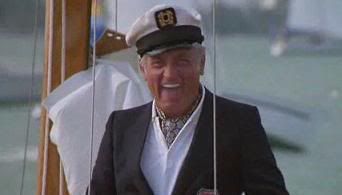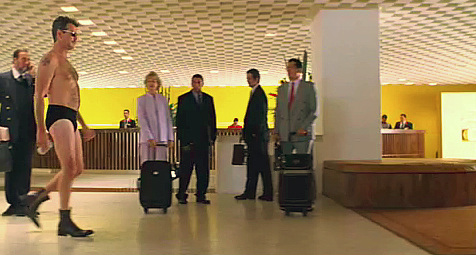 |
| Ben Kingsley and Patricia Clarkson in "Learning to Drive." Image courtesy Broad Green Pictures. |
I’m not sure if anyone does this anymore given access to the Internet just about everywhere, but there was a time when people would pop by a cineplex and dither about which film they wanted to see. The battle could get a little heated if one party, say an older and larger brother, didn't hold more sway over the other, and the multitude of options at the 20-screen theaters only made the process that much more difficult.
I bring this up because “Learning to Drive” is the perfect settle film, a movie the attendees – more likely than not a couple – have a passing familiarity that feature actors on the poster they feel comfortable watching. Settle films like “Learning to Drive” aren't memorable pieces of cinema, but they have just enough to keep an audience engaged and satisfied for at least 90 minutes, and nobody leaves the theater overly upset with what he or she just watched.
One thing “Learning to Drive” has going for it is a title that isn't a misnomer: the film is literally about Sir Ben Kingsley teaching the great Patricia Clarkson (one of the few actors to earn the word “great” as part of his or her title) how to navigate an automobile. Clarkson never had a reason to learn before – as a native New Yorker she relied on subways and other people – but is inspired to do so after her husband (Jake Weber) leaves her for another woman. Taking a few driving lessons offers Clarkson an opportunity to escape her post-marital woes while at the same time serving as a means of connecting with her Vermont-based daughter (Grace Gummer, the GREAT Meryl Streep's daughter).
 |
| Also in that category: the Great Laura Linney. |
As Clarkson struggles with the end of her marriage, Kingsley is trying to create a domestic life of his own. An Indian Sikh who fled to America seeking political asylum, Kingsley works both as a driving instructor and as a taxi driver to support his nephew (Avi Nash) and his new wife (Sarita Choudhury) from an arranged marriage. Kingsley swears by the arranged-marriage system, although the match starts off on the wrong foot due to an initial intellectual and cultural divide between the newlyweds.
As you probably guessed, the title “Learning to Drive” works as both a literal description of the film's plot and a symbolic representation of what the act of gaining independence does for Clarkson's character and what domesticity does for Kingsley. It’s a little less than subtle for sure, albeit a name that does serve as a pretty good indicator of the film's tone. “Learning to Drive” is exactly as agreeable as it sound, complete with soft-chuckle inducing comedy (there is one exception courtesy a filthy Samantha Bee joke) and inoffensive drama in which the results perfectly satisfy what the audience would want given the circumstances. Surprises or any true sense of concern and danger do not lurk in the shadows of this film.
It loses a few points for lacking such things, as well as a weird undertone of sexism with Kingsley's character. (He gets upset at his wife for not leaving the apartment, even though it remains unclear whether he at least gave her a tour of her new neighborhood or not). Issues abound too with unnecessary dips into magical realism and the disparity between the moderately rich literati lifestyle Clarkson lives against the poverty Kingsley lives in; while it's not quite snobs vs. slobs, the filmmakers do put a little more weight on Kingsley's problems for economic reasons.
 |
| Ted Knight is not around to flaunt his mysterious wealth either. |
Those issues are more like hills than mountains though, concerns worth stewing over without impeding upon the film's enjoyment. The fun comes from watching Clarkson and Kingsley, both of whom are nothing less than terrific and put in nuanced performances that, in Clarkson's case, only reach histrionics when the moment calls for it. They also have a terrific rapport, saying very much to each other without speaking more than necessary; the moments of silence both calm and awkward serve as their own form of communication.
Director Isabel Coixet and writer Sarah Kernochan have crafted a perfectly lovely little film with “Learning to Drive.” Their movie makes for a short pleasant trip to the theater – or a solid Netflix rental accompanied by an OK Portuguese pinot noir and a good acquaintance – that doesn't leave too bitter a taste in the mouth afterward.
 |
| Although you might want to watch out for the dreaded wine headache. |
Review: Three and a half out of Five Stars
Click here to see the trailer.
Rating: R
Run time: 90 minutes (One hour and 30 minutes)
Genre: Drama
Ask Away
Target audience: Anyone down for spending 90 minutes with the marvelous Patricia Clarkson.
Target audience: Anyone down for spending 90 minutes with the marvelous Patricia Clarkson.
Take the whole family?: One of those films were the content is barely in the “R” territory but the tone and nature of it makes it for older audiences regardless.
Theater or Netflix?: Really, really excellent for either an adult date night or just a night in, so either works as long as a hint of vino is involved.
Academy Award odds?: Ben Kingsley has a decent shot if the best lead actor field doesn't get too crowded (the last couple of years have just been insane) and if someone like Paul Dano gets bumped to supporting actor. Patricia Clarkson might have the better shot for the same award in the opposite gender though given the comparatively low competition level and for the moderate intensity of her performance.
Watch this as well?: Considering how much of an acting showcase this is for Clarkson and Kingsley, it feels apropos to recommend two other films in which both shine: “Pieces of April” for the former and “House of Sand and Fog” for the latter.






